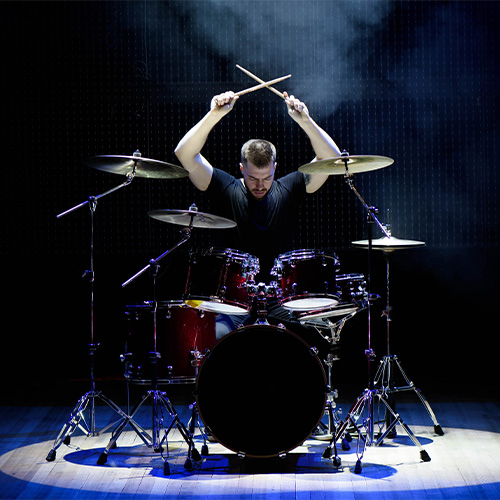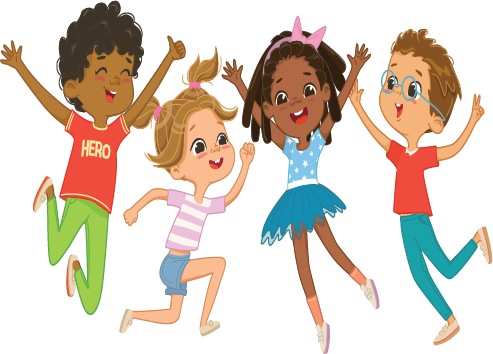Lesson 16. Present modern music genres
Prior learning: None
Duration: 30 minutes
Materials: Woodblocks or claves
Keywords: Beat, rhythm, singing, chanting, partners, rhymes, circle games.
Difficulty: ![]()
Prepare
Present
Modern music genres
Practise
 Melodic development
Melodic development
![]() Students
Students
 Rhythmic development
Rhythmic development
![]() Students listen and count the drum beats to determine the metre.
Students listen and count the drum beats to determine the metre.

- Begin by explaining that in many modern music genres, drums and percussion are crucial for establishing the beat and rhythm, driving the energy and feel of the song.
- Highlight how different rhythmic patterns create distinct atmospheres and styles.
- Play Track 1: Tell the students to listen carefully to identify the rhythmic pattern and the instruments creating the beat before playing.
- After the track plays, ask which instrument(s) primarily create the rhythm. [drums, percussion]
- Ask students to describe the pattern of strong and weak beats. Guide them to recognise patterns, such as strong-weak-weak.
- Ask what kind of metre this pattern suggests. Lead them to identify triple metre (3/4 time)
- Play Track 2: Ask students to listen for rhythm and beat pattern changes. Encourage them to tap or clap along to help identify the metre.
- Ask the pattern of strong and weak beats (e.g., strong-weak-weak-weak, suggesting quadruple metre)
- Ask which metre fits this pattern. [ quadruple metre or 4-metre]
- Play Track 3: Repeat the listening and analysis process, encouraging students to listen critically and describe the rhythmic differences.
- Here, the track has a strong-weak pattern, indicating duple metre.
- After all tracks, have students compare the rhythmic patterns and discuss how different metres create different feels.
- Ask which metre you find most engaging or familiar and why.
- Connect to Genres: To solidify understanding, relate each metre to common modern genres (e.g., the triple metre in waltz-like ballads, the duple and quadruple metre in pop and rock).
 Creative movement
Creative movement
![]() Students use creative movement to form musical sculptures in response to music.
Students use creative movement to form musical sculptures in response to music.

- Explain to the students that they will create "sculptures" with their bodies reflecting the music they hear.
- Encourage them to think about how the music makes them feel and how they can express that feeling with their bodies.
- Play a music track and let the students move freely around the space, responding to the rhythm and mood of the music.
- At random intervals, pause the music and shout, "Freeze!"
- When the music stops, each student must freeze in a pose that reflects the last movement they were making or the mood of the music.
- After each freeze, walk around and observe the "sculptures." Ask a few students to explain their poses and how they relate to the music.
- Discuss as a class how different students interpreted the same music differently.
- Play a new track with a different tempo or mood. Repeat the process, allowing students to explore new movements and poses.
 Listening
Listening
![]() Students listen to examples of modern music genres.
Students listen to examples of modern music genres.
The rhythms and beats of the modern music genres discussed in the lesson each have distinct characteristics that can be explored with students:
Pop Music:
- Rhythms: Pop music typically has straightforward and consistent rhythms, making it easy to dance to. The rhythm often follows a 4/4 time signature, strongly emphasising the downbeat.
- Beats: The beat in pop music is usually steady and repetitive, often with a snare or clap on the second and fourth beats of each measure. This gives pop music its catchy, predictable feel.
Rock Music:
- Rhythms: Rock music often features more dynamic rhythms, emphasising syncopation and varying patterns. The rhythm can range from simple to complex, depending on the style of rock.
- Beats: The beat in rock is usually driven by the drums, with a strong backbeat on the second and fourth beats of the measure. The bass drum typically keeps a steady pulse, while the snare drum adds punch, creating a powerful and energetic feel.
Hip-Hop:
- Rhythms: Hip-hop rhythms are typically complex and syncopated, strongly emphasising the groove. The rhythms often complement the flow of the rapper's lyrics, creating a strong sense of movement and energy.
- Beats: The beat in hip-hop is characterised by heavy bass, often with a deep kick drum and sharp snare hits. The rhythm section might include hi-hats or claps that create a sense of swing or groove, making the beat feel lively and engaging.
Electronic Music:
- Rhythms: Electronic music features highly repetitive rhythms, often created with drum machines or synthesisers. The rhythm is usually consistent, designed to keep people moving on the dance floor.
- Beats: The beat in electronic music is often defined by a strong, steady pulse, usually with a four-on-the-floor pattern (a bass drum hit on every beat in 4/4 time). This creates an intense, driving rhythm that’s perfect for dancing.
R&B (Rhythm and Blues):
- Rhythms: R&B rhythms are smooth and often laid-back, with syncopation that adds groove and flow to the music. The rhythm supports the vocal melody, allowing it to take centre stage.
- Beats: The beat in R&B is typically soft and subtle, with a strong sense of groove. The bass and drums work together to create a relaxed yet deeply soulful rhythm, often emphasising the off-beats or syncopated hits to add to the music’s emotional impact.
Each of these genres uses rhythm and beats in ways that define their unique sound, making it easier for students to recognise and appreciate the differences between them.
Play examples of different music genres to the class. Ask if they can recognise the genre of each track.
 Visual learning
Visual learning
![]() Students must discover the possible genres of music shown by musicians.
Students must discover the possible genres of music shown by musicians.
- There is no right or wrong answer here. The idea is to show students examples of musicians performing certain genres of music.
- Discuss each photo with the class and ask about the possible genre.
 Instruments
Instruments
![]() Students
Students
 Part work
Part work
![]() Students sing and improvise body percussion in an ostinato pattern.
Students sing and improvise body percussion in an ostinato pattern.
- Compose a simple four-beat body percussion pattern using clapping, patsch, clicking, taping, etc., on different parts of your body.
- Lead the class in singing the song and demonstrate the ostinato pattern (you might need to practice this!)
- The class should sing the song and mirror your movements.
- When secure, ask a volunteer to create their pattern, which the class will copy as they sing again.
- Repeat with other volunteers.
 Assess
Assess
Suggested lessons
Y1. Beat II

Y1. Beat III

Y1. Beat IV


